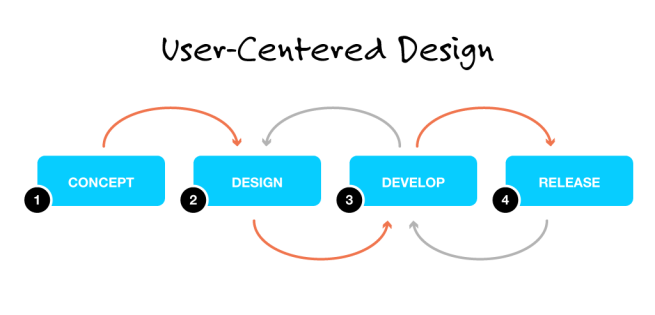WEB204 » Introduction to User Requirements & Research Methods
The term User Requirements refers to the features or attributes that your product should have and how the user thinks that it should perform. This in turn requires the designer to use the discipline of User-Centered Design to collect and analyze these User Requirements.
What is Usability?
Usability is a quality attribute that assesses how easy user interfaces are to use. The word “usability” also refers to methods for improving ease-of-use during the design process.
See Also: Usability 101: Introduction to Usability | Nielsen Norman Group
What is User-Centered Design?
User-Centered Design (UCD) is a product development approach that focuses on the end users of a product that adhere’s to the philosophy that the product should suit the user’s needs.
The main principles involved in User-Centered Design are:
- An early focus on Users and their Tasks
- Empirical Measurement of Product Usage
- Iterative Design
The art and science of User-Centered Design comes down to the application of User-Centered Design principles via research methodologies into the product design and development lifecycle.
See Also: Summertime at the University | Mike Sinkula
This User-Centered Design cycle becomes an “iterative design” production cycle:
1) Stage One: Concept
This is the ideation phase where you might use activities such as:
- Competitive Analysis
- Goals & Objectives
- Surveys
- Persona Development
2) Stage Two: Design
This is the iterative design phase where you might use activities such as:
- Card Sorting
- Paper Prototyping
- Task Analysis
- User Interviews
- User Focus Groups
- User Evaluation
- Heuristic Evaluation
3) Stage Three: Develop
This is the production phase where you might use activities such as:
- Usability Testing
- Design Reviews
- Heuristic Evaluation
4) Stage Four: Release
This is the validation phase where you might use activities such as:
- Competitive Usability Testing
- Benchmark Testing
- Feedback Surveys
How do I conduct User Research?
The big myth is that gathering user requirements take s too much time and costs too much money. Not true. there are many activities that can be conducted on a tight budget and within time constraints.
1) Interviews & Surveys
Interviews one of the most common and easiest methods to use to gather requirements. It is amazing the amount of information one can gather by having a conversation with a user of a product.
2) Competitive Analysis
A competitive analysis of web content is an assessment of competing websites based on your content goals. This could be an assessment of branding, usability, accessibility, information architecture, or any other element of your web or content strategy.
See Also:
- Conducting a Competitive Analysis | MeetContent
- Project Plan for Doebay.com Website Redesign | Rebecca Destello
3) Wants & Needs Analysis
A Wants & Needs Analysis is an inexpensive brainstorming activity for any product that results in a prioritized list of users’ wants and needs.
See Also: Research Activity Report: Wants & Needs Analysis | Mike Sinkula (et al)
4) Heuristic Evaluation
According to Nielsen, Heuristic evaluation is another discount usability engineering method that is perfect for quick, cheap, and easy evaluation of a user interface design. It involves having a small set of expert evaluators examine the interface and judge its compliance with recognized usability principles.
See Also:
- Research Activity Report: Heuristic Evaluation | Mike Sinkula (et al)
- 10 Usability Heuristics for User Interface Design | Nielsen Norman Group
5) Card Sorting
Card Sorting is a popular and inexpensive user-centered research methodology that allows the researcher to collect data from website user groups in terms of how information on a website should be grouped, organized and labeled according to the user’s mental model.
See Also:
- Using Card Sorting To Test Information Architecture | MesuringU
- Card Sorting the Human Centered Design & Engineering Website Information Architecture | Mike Sinkula (et al)
6) Usability Testing
According to Nielsen, The most basic and useful way to test usability is through the process known as Usability Testing. This is where representative users perform representative tasks while a moderator observes what the user does, where they succeed, and where they have difficulties with the user interface.
See Also:
- Research Activity Report: Usability Testing with User Sketches | Mike Sinkula (et al)Seattle Central Community College (SCCC) Usability Testing Report | Mike Sinkula, Asmi Joshi, Bob Kittle, & Yoel Sumitro
- Seattle Central Community College (SCCC) Usability Testing Presentation | Mike Sinkula, Asmi Joshi, Bob Kittle, & Yoel Sumitro
This portion of the Premium Design Works website is written by Mike Sinkula for the Web Design & Development students at Seattle Central College and the Human Centered Design & Engineering students at the University of Washington.













Social